We headed east along the northern Honduran coast. Tela was supposed to be a laid back beach town, but turned out to be a down-at-heel scruffy place, with awful internet connections and dubious eateries. It reminded us rather of Southend-on-Sea. Even the beach wasn't that good. We ploughed on to La Ceiba, Honduras' third largest town. La Ceiba has more to it (like half decent internet), but nothing to really make us stay, so we headed over to the dock hoping to get some sun on the Bay Islands.
A rather rocky ferry passage on the ‘Utila Princess’ - a nippy catamaran, got us to Utila, one of the three Bay Islands in the gulf of Honduras. We had booked an apartment for the week. As we were docking, the heavens opened and we got utterly soaked walking up the hill to get to our digs. This was a foresight of things to come. Utila is a small island with one hill, a lot of lagoons and mangrove swamp, an airfield and Utila town, which is not much more than a street around a bay.
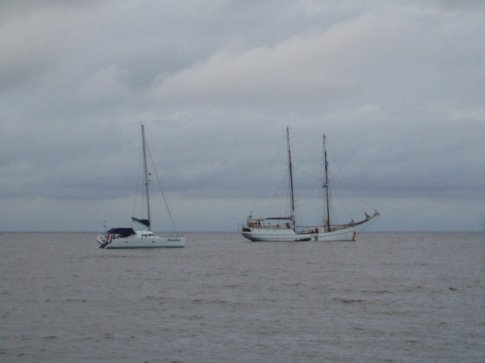
Mine'll be a schooner please. Oh, go on...
The island is really known as a cheap-as-chips place to learn SCUBA diving. At first we weren’t going to bother because of the cost, but, well, we were in one of the cheapest places in the world to learn, and hey, there isn’t an awful lot else to do on Utila.
One of the strange things about the Bay Islands is that most people speak English, as it was a haunt for English pirates, and was part of the area controlled by the British along with Belize and the Mosquitia region when we were doing our 'thorn in the flesh of the Spanish' thang. Saying that, most of the locals speak Creole amongst themselves, which is as near English as Glaswegian; eg: not very.
The islands are pretty laid back and if you ask when a dive boat is going to leave, its kind of when you get there, plus some sitting around time. The only non-laid back thing is the fact that as you walk the high st (eg: a 3m wide pavement), you have to constantly dive out of the way of locals on speeding motorbikes, mopeds, trucks and golf buggies (!). Considering the amount of road available on the island (probably about 2 miles in all), I was a bit dubious about the utility of these vehicles. I guess its the sad old story of 'we can afford them, therefore we'll 'ave 'em'. Next year they'll be driving Humvies.
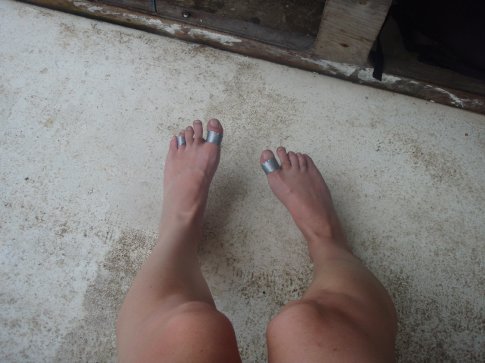
Note innovative use of duck-tape to keep flipper-blisters at bay...
The first day Rachel and I booked in to a dive shop to do our ‘Open Water PADI certification’, and then got some fins and masks and went snorkeling at a spot recommended. However, when we got in the water we were soon in the middle of a nasty slick of brown oily stuff on the surface, which reduced the visibility somewhat and made us head for the shore pretty quickly. Turns out it wasn’t bilge water, or sewage, but ‘mangrove juice’ - decayed plant matter and oils that’s washed out of the mangrove in rainy weather. Anyway, we went up the coast a little and went in again, and this time saw a Barracuda (smaller than the one at Zapatillas, but still, big enough) and also an octopus hiding in a rock, which was very cool and usually they only come out at night, apparently.
Over the next few days we started our diving theory and also went to a talk by a marine biologist studying whale sharks. These are the biggest fish in the world. They’re filter feeders with dark bodies spotted with white. They congregate around Utila at certain times of year to feed on ‘bait balls’ of krill and zooplankton. Unfortunately it was the wrong time of year for us to see them, but it was great to learn about them. Utila is good, as they have regulations in place so that there’s no scuba diving with the sharks, and no chasing them round with dozens of tour boats (unlike our experience with the dolphins at Bocas).
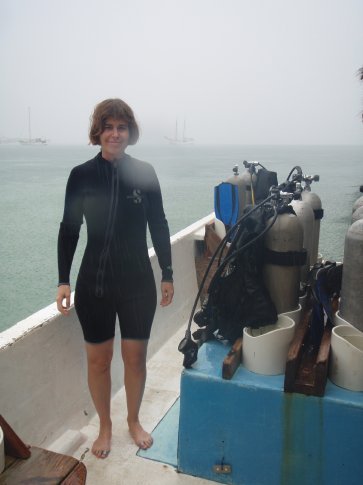
Rachel kitted up and ready for action! (note nasty weather)
We started our dive training proper with so called ‘controlled water’ dives - which basically means in a couple of metres of water. You start by learning how all the kit works and how to put it on and off, then you start doing lots of different drills underwater, like clearing your mask, taking off your mask, weights, your whole scuba gear (!) and fun things like switching off your air supply, so forcing you to use your buddy’s second regulator. Our first day out was rainy and very choppy. Visibility in the water was down from about 15m to about 2m and there was a wicked swell. As you can imagine, doing drills involving taking off your life support systems when you can’t see anything and you're beig pulled around by the swell isn’t very fun. As a result Rachel wasn’t very keen the next day to carry on. However, I could count on her natural stubbornness not to be beaten by something, so we some trepidation, she got back in the water the next day!
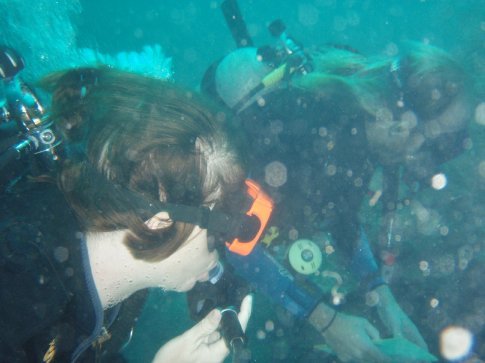
Animal, Vegetable, Mineral? Rachel learns to identify her octocorals from her hexacorals
The next day was much better and soon we were doing our first ‘open water’ dives in depths of 12m or so, on reefs and walls. It soon becomes second nature to equalise your ears and mask, although getting the right buoyancy (staying at one depth and not sinking or rising) took a bit more practice. We finished up with a day doing a marine naturalist course, where we went through the different types of corals, sponges and invertebrates with the dive shop’s resident marine biologist before going out with him to identify everything in the field.
It was fantastic to see the variety of biodiversity on the reefs. Even though you get to see many of the same things just snorkeling, it is very fun to be able to get up close to fish, and to look up and watch sea fans swaying in the current above you, backlit by the sun, with shoals of little reef fish bobbing around them - or to look into sponges and see tiny shrimp with long stripey antennae hiding in them.
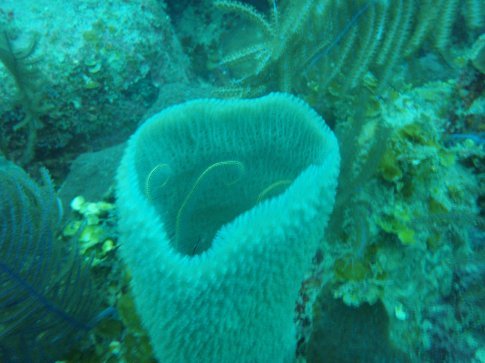
Whose hiding in the sponge?
Our highlights were seeing a rare lesser electric ray - with a big chunk out of him (I wonder if the attacker lived to enjoy the chunk…), beautiful spotted eagle rays and a female hawksbill turtle grazing the algae off a rock, seemingly quite happy to have us strange ponderous things around.
So, we’re now certified scuba divers - see we have learned something this year after all! (as well as Spanish - ish for me). We’re looking forward to more salty adventures in Belize and the Yucatan.

Chromis in motion...
After a week in Utila we caught the ferry back and then executive-bused it (we decided to have a break from the chicken buses) to Puerto Cortes in the far northwest, where we aimed to get a ferry to Belize - our fifth country!
For more pictures of nice corals n' fish, and things, click here:
http://journals.worldnomads.com/rachel_and_daniel/gallery/14805.aspx